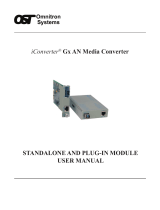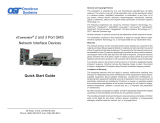Page is loading ...

iConverter
®
T1/E1 Plugin Module USER MANUAL
The iConverter T1/E1 media converter provides standard T1 (1.544Mbps) or E1
(2.048Mbps) copper to fiber conversion and can be used to extend the demarcation
point between service provider and networking equipment. T1/E1 media converters
operate in pairs, extending distances over fiber, which improves noise immunity, quality
of service, intrusion protection and network
security.
The T1/E1 supports Small Form Pluggable
(SFP) transceivers, enabling adaptability to
different fiber types, distances and
wavelengths, providing maximum flexibility
across a variety of network architectures and
topologies.
Management of the plug-in module is
accomplished by using a Management
Module
1
(such as an iConverter NMM2 or 10/100M2) that provides monitoring,
configuration and trap notification.
INSTALLATION PROCEDURE
1) Configure DIP-Switches
2) Install Module in the Chassis and Connect Cables
3) Verify Operation
1) CONFIGURE DIP-SWITCHES
FRONT PANEL DIP-SWITCHES
SW1 - LOCAL DUAL LOOP-BACK
“LOOP”
When this DIP-switch is set to the “Loop”
position, it sets the
iConverter T1/E1
converter to a dual loop-back mode (see
Figure B) on both the fiber and copper
connections. By returning the
DIP-switch to the “Norm” position, the
unit resumes normal operation.
SW2 - FIBER OPTIC TEST “FOT”
This DIP-switch will allow the entire fiber
segment to be tested at either of the
iConverter T1/E1 converters without
having to set DIP-switches on both units.
When this DIP-switch is set to “FOT”,
the local unit (the unit with the DIP-switch in the “FOT” position) is switched into local
loop-back mode. In addition to the local loop-back mode of operation, the fiber TX port
is further encoded to carry a remote loop-back protocol. This remote loop-back protocol
sets the remote unit at the other end of the fiber link to a remote loop-back mode of
CABLE SPECIFICATIONS:
UTP Cable for T1 and E1
Gauge 22 to 24 AWG
Impedance 100 ohms +/- 10%
Impedance Characteristic 2.6dB/100M @ 1Mhz
Maximum Distance T1 6,000 ft E1 8,000 ft
Coax Cable for E1
Gauge 22 to 24 AWG
Impedance 75 ohms +/- 10%
Impedance Characteristic 2dB/100M @ 1MHz
Maximum Distance 8,000 ft
3) VERIFY OPERATION
Once the module has been installed and configured per steps 1 and 2, verify the
module is operational by viewing the LED indicators.
The Power LED indicates the module is receiving power.
The Fiber Optic link LED indicates the fiber optic connection has been established.
The UTP LED indicates a T1/E1 signal has been detected.
If the Fiber Optic LED is blinking, the port is receiving an all 1s signal. This will occur
if the UTP port is not connected.
LED Function
"Legend"
Color OFF State ON State
Power
"Pwr"
Amber No power Module has power
Fiber Optics
"F/O Lk"
Green No Fiber Link
On: Fiber signal detected
Blinking: All ones received
Test
"Tst"
Amber Normal
On: Loop or All ones Test Mode
Blinking: FOT Received - Local
Fast Blinking: FOT Received - Remote
UTP
"UTP Lk"
Green No UTP Link
On: UTP signal detected
Blinking: All ones received
1
For complete management support, use a M2 series module (NMM2, GX/TM2, 2GXM2,
10/100M2, 2FXM2) or higher. The T1/E1 SFP (8719-0) module must be at rev xx/10 or greater.
Form 040-08700-002 B 5/09
Omnitron Systems Technology * 140 Technology Dr. #500 * Irvine, CA 92618
949.250.6510 tel * 949.250.6514 fax * www.omnitron-systems.com
Figure A: DIP-Switch Location

DIP-SWITCH BANK 1
BOARD MOUNTED DIP-SWITCH SETTINGS:
T1/E1 Copper Line Configuration Settings:
The T1/E1 copper line codes and line lengths are configured using board mounted
DIP-switches.
Line Type Port Type Distance
DIP-Switch Position
1234
T1 DSX-1
(default)
RJ-45/48 0' to 133' Down Down Down Down
T1 DSX-1 RJ-45/48 133' to 266' Down Down Down Up
T1 DSX-1 RJ-45/48 266' to 399' Down Down Up Down
T1 DSX-1 RJ-45/48 399' to 533' Down Down Up Up
T1 DSX-1 RJ-45/48 533' to 655' Down Up Down Down
T1 DS1 RJ-45/48 0 dB Down Down Down Down
T1 DS1 RJ-45/48 -7.5 dB Down Up Down Up
T1 DS1 RJ-45/48 -15 dB Down Up Up Down
T1 DS1 RJ-45/48 -22.5 dB Down Up Up Up
E1 75 ohm Coax/BNC Standard Up Down Down Down
E1 120 ohm RJ-45/48 Standard Up Down Down Up
E1 75 ohm Coax/BNC Extended Up Down Up Down
E1 120 ohm RJ-45/48 Extended Up Down Up Up
2) INSTALL MODULE IN CHASSIS AND CONNECT CABLES
a. Carefully slide the module into an open slot in the chassis. Align the module with
the installation guides and ensure that the module is firmly seated against the
backplane. Secure the module by fastening the front panel thumbscrew (push in
and turn clockwise to tighten) to the chassis front. Verify the “Pwr” LED is ON
(indicating the chassis is powered).
b. When using the SFP model (8719-0 or 8739-0), insert the SFP Fiber transceiver
into the Port 1 SFP receptacle on the T1/E1 converter (see the SFP Data Sheet
091-17000-001 for supported transceivers).
NOTE: The release latch of the SFP Fiber transceiver must be in the closed
(up) position before insertion.
c. Connect to the RJ-45/48 connector on the
iConverter T1/E1 converter via a Category 3
or better cable (Category 5 is recommended), and attach the other end to the network
equipment.
d. Connect an appropriate multimode or single-mode fiber cable to the fiber port of
the installed module. It is important to ensure that the transmit (TX) is attached to
the receive side of the device at the other end and the receive (RX) is attached to
the transmit side. Single-fiber (SF) media converter models operate in pairs. The
TX wavelength must match the RX wavelength at the other end and the RX
wavelength must match the TX wavelength at the other end.
operation and returns a signal to the local unit (see Figure C). A slow blinking “Tst”
LED on the local unit and a fast blinking “Tst” LED on the remote unit shows confirmation
that the fiber segment is communicating properly between devices. By returning the
DIP-switch to the “Norm” position, the unit resumes normal operation.
Figure B: Dual Loopback Mode
Figure C: Fiber Optic Test Mode
SW3 - FORCE 1S TO FIBER “FO1”
When this DIP-switch is set to the “FO1” position, an “all ones” pattern is inserted
into the data stream being transmitted out of the fiber port on the
T1/E1 converter. Data being received on the coax or twisted pair is disabled and
data being received on the fiber is passed through to the coax or twisted pair side. By
returning the DIP-switch to the “Norm” position, the unit resumes normal operation.
SW4 - FORCE 1S TO COAX OR UTP “CU1”
When this DIP-switch is set to the “Cu1” position, an “all ones” pattern is inserted into
the data stream being transmitted out of the coax or twisted pair port on the
T1/E1 converter. Data being received on the fiber will be disabled and data being
received on the coax or twisted pair is passed through to the fiber side. By returning
the DIP-switch to the “Norm” position, the unit resumes normal operation.
SW1 AND SW2 - AMI/B8ZS/HDB3 MODE
B8ZS (T1) or HDB3 (E1) is the default line encoding mode of operation. To select AMI
mode, enable both the Local Dual Loop-back “Loop” and Fiber Optic Test “FOT”
DIP-switches on the front of the module.
PUSH BUTTON - MANUAL CROSSOVER “= / X”
The Manual Crossover “= / X” button located on the front panel is used to eliminate the
need for crossover and custom cables when connecting devices to the RJ-45/48 port.
When the button is in the out “=” position, the port is configured for a straight-through
cable. When the button is in the in “X” position, the port is configured for a crossover
cable. The twisted pair connection requires two active pairs in a T1/E1 environment.
The active pairs are pins 1 & 2 and pins 4 & 5. Only dedicated wire pairs should be
used for the active pins.
/










